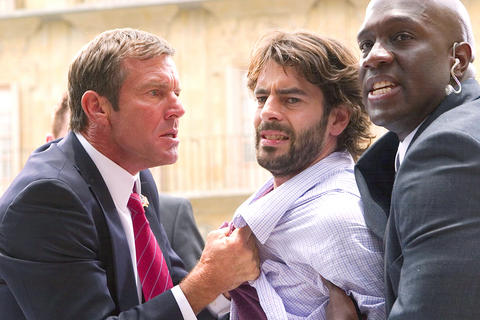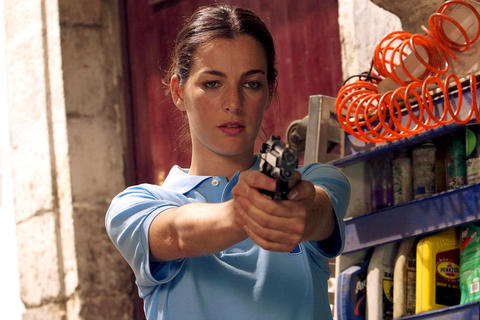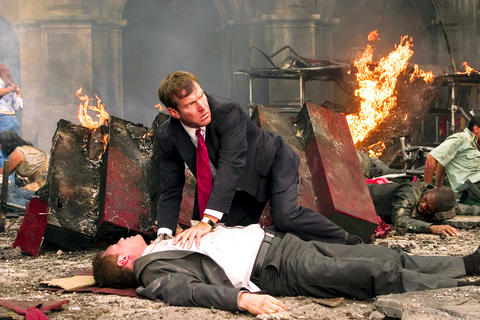Vantage Point, a gimmick in search of a point, is nothing if not, er, timely. Set in the picturesque Spanish city of Salamanca (otherwise known as Mexico City), this jigsaw puzzle exploits a repellent conceit - the shooting of an American president (William Hurt, effectively insincere) - in a vague attempt to explore questions of narrative and subjectivity (like Rashomon) through the box-office-friendly form of a thriller (like the Bourne flicks). Instead of pushing the story forward, the filmmakers instead repeatedly return to the crime, or rather to a handful of witnesses, all of whom saw the same exact event from critically different angles.
Vantage Point, a gimmick in search of its own point, is nothing if not, er, timely. Set mostly in a Spanish city, it has been given a hard sheen by the director Pete Travis, working from a screenplay by Barry Levy. This is competent if completely impersonal filmmaking of a familiar type that finds the usual allotment of famous, or at least famous enough, actors - Dennis Quaid, Forest Whitaker, Matthew Fox and Sigourney Weaver - arranged in various configurations in assorted spaces and delivering instantly forgettable dialogue. What does register: a slimmed-down Whitaker looks as sleek as an otter, Fox is probably best cast to nice type, and Weaver seems too big for her small bit as a television producer.
Vantage Point, a gimmick in search of its own point, is nothing if not untimely. This is less a matter of topicality (this is, of course, a presidential election year) than a problem of timing, in other words pacing, narrative flow, direction. In Rashomon, Kurosawa gives you four versions of the same incident and does so brilliantly. Here we get so many versions and viewpoints that a preview audience started to complain audibly each time the clock was reset, though this probably had less to do with the fractured storytelling than its lack of brilliance. In truth, with Rashomon, you really get five versions of the same anecdote because the most important belongs to the filmmaker, a vantage point that's missing from this newer work.

PHOTO: COURTESY OF SON
Vantage Point - well, you get the point.

PHOTO: COURTESY OF SON

PHOTO: COURTESY OF SON

The canonical shot of an East Asian city is a night skyline studded with towering apartment and office buildings, bright with neon and plastic signage, a landscape of energy and modernity. Another classic image is the same city seen from above, in which identical apartment towers march across the city, spilling out over nearby geography, like stylized soldiers colonizing new territory in a board game. Densely populated dynamic conurbations of money, technological innovation and convenience, it is hard to see the cities of East Asia as what they truly are: necropolises. Why is this? The East Asian development model, with

June 16 to June 22 The following flyer appeared on the streets of Hsinchu on June 12, 1895: “Taipei has already fallen to the Japanese barbarians, who have brought great misery to our land and people. We heard that the Japanese occupiers will tax our gardens, our houses, our bodies, and even our chickens, dogs, cows and pigs. They wear their hair wild, carve their teeth, tattoo their foreheads, wear strange clothes and speak a strange language. How can we be ruled by such people?” Posted by civilian militia leader Wu Tang-hsing (吳湯興), it was a call to arms to retake

This is a deeply unsettling period in Taiwan. Uncertainties are everywhere while everyone waits for a small army of other shoes to drop on nearly every front. During challenging times, interesting political changes can happen, yet all three major political parties are beset with scandals, strife and self-inflicted wounds. As the ruling party, the Democratic Progressive Party (DPP) is held accountable for not only the challenges to the party, but also the nation. Taiwan is geopolitically and economically under threat. Domestically, the administration is under siege by the opposition-controlled legislature and growing discontent with what opponents characterize as arrogant, autocratic

When Lisa, 20, laces into her ultra-high heels for her shift at a strip club in Ukraine’s Kharkiv, she knows that aside from dancing, she will have to comfort traumatized soldiers. Since Russia’s 2022 invasion, exhausted troops are the main clientele of the Flash Dancers club in the center of the northeastern city, just 20 kilometers from Russian forces. For some customers, it provides an “escape” from the war, said Valerya Zavatska — a 25-year-old law graduate who runs the club with her mother, an ex-dancer. But many are not there just for the show. They “want to talk about what hurts,” she